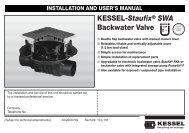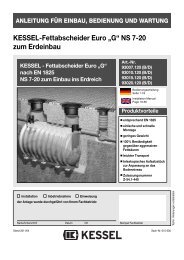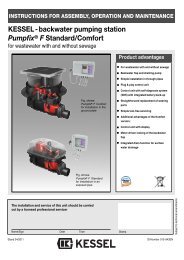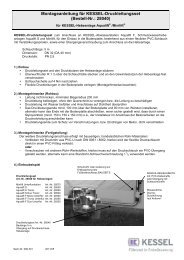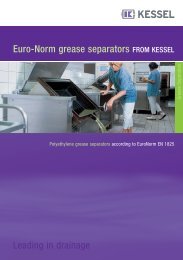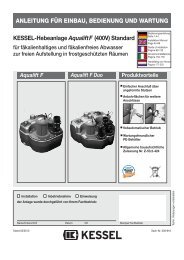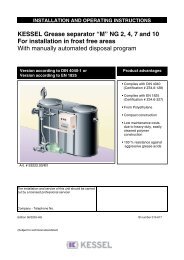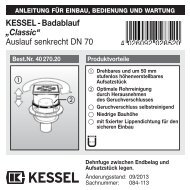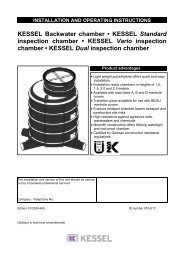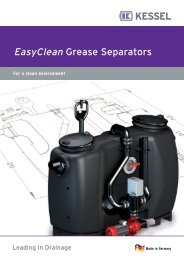4. Installation et montage - Kessel
4. Installation et montage - Kessel
4. Installation et montage - Kessel
Create successful ePaper yourself
Turn your PDF publications into a flip-book with our unique Google optimized e-Paper software.
5. CommissioningPlug the mains plug of the control unit into the sock<strong>et</strong>. The plantwill initialise automatically.Note: The mains power supply cable must be equipped with afault current circuit breaker.During the first initialisation of the plant, the control unit requestsfour basic s<strong>et</strong>tings. The control unit display shows a query for1. the language for the user prompting2. the date and the time3. the desired purification class C or D<strong>4.</strong> the required nominal size of the plant.By pressing the movement keys / direction keys, the desireds<strong>et</strong>ting can be highlighted with a marking bar. Pressing theenter key stores the selected s<strong>et</strong>ting in the system memory. Assoon as the 4 pres<strong>et</strong>tings have been made, the control unitloads the program memory and automatically enters into operatingmode.The plant is now ready for operation.Notes on sludge recirculation:The recirculation of activated sludge is necessary to preventthe formation of an excessively large quantity of activatedsludge. This excessive quantity of activated sludge couldlead to problems at the outl<strong>et</strong> of the sewage plant and havean adverse effect on existing French drains. The recirculatedsludge is deposited in the primary sedimentation chamberand is discharged with the next primary sludge disposal.The sludge recirculation control can be s<strong>et</strong> using the timesT20 & T21. After the plant has been put into operation, bothsludge recirculation systems should be disabled for the first3 to 5 months in order to guarantee faster establishment ofthe biology. In addition, it makes sense to reduce the T20 s<strong>et</strong>ting("Recirculation holiday phase") after every primary sludgedisposal (see item 6.4 Disposal) in order to avoid too muchactivated sludge being discharged. For good purifying resultsyou should make sure that there is b<strong>et</strong>ween 300 ml/l and 600ml/l activated sludge in the activated sludge tank, dependingon operating conditions. If this value should not be achieved,reduce or increase the pres<strong>et</strong> sludge recirculation values.You will find the factory default s<strong>et</strong>tings on page 121.5.2 Operator's dutiesChecking- for transport or installation damage- for structural defects- all electrical and mechanical components for seat and function- floater function- hose connections- line connections- syphons (see point 8)- aerator5.3. Instruction of the customer based on the installationinstructions- Perusing the installation and operating instructions with the customer- Operating the plant (explaining and describing)- Explaining the operator duties to the customer (disposal, maintenance,operation of a small biological sewage treatmentplant, operations diary)6. Operation and disposal6.1 OperationAfter commissioning of the plant, an active activated sludgelayer with microorganisms forms in the aeration chamberafter 3-6 months. It is not necessary to feed any microorganismsto this plant. We however consider a feeding of activatedsludge from the nearest sewage treatment plant reasonable.Important: Only feed activated sludge into the aerationchamber!To ensure a smooth operation, maintenance intervals hav<strong>et</strong>o be strictly adhered to. The timely emptying of the preliminarysedimentation chamber must be ensured.The operation of the small sewage treatment plant is fully automatic.In d<strong>et</strong>ail, there are three phases, the "normal", "economy"and "holiday" phase. These differ with regard to theiraeration time and quantity. The actual purification takes placeduring the normal phase (6 hours).In case of an inadequate feeding of the plant (insufficient sewageinflow), it will automatically switch to the "economyphase" (2 hours). In this phase, the aeration time is reducedto the lower sewage quantity, to prevent "starving out" the adaptedmicroorganisms. If the plant remains in the "economyphase" for a longer period of time (8 hours), it automaticallyswitches to the "holiday phase".The "holiday phase" is characterised by an even lower supplyof oxygen. Supplementary to that, a defined amount ofsludge is conveyed from the aeration chamber into the preliminarysedimentation at the end of the holiday phase. Thismakes it possible to supply a certain amount of nutrients tothe aeration phase during the next feeding. This contributestowards the preservation of the biology during a prolongedstandstill.115




